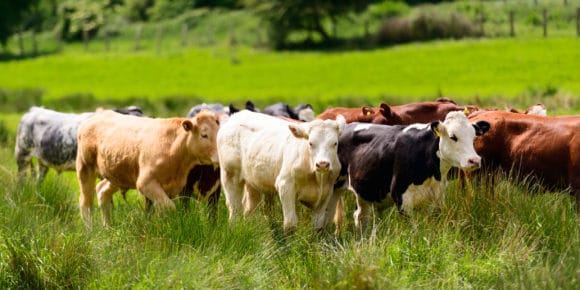By Shorouk Elkobros, 2020 IIASA Science Communication Fellow
Being mindful of biodiversity loss and environmental impact can disrupt the beef industry globally, here’s how.
In his new polemical Netflix documentary, A life on our planet, Sir David Attenborough argues that, “We live on a finely tuned life support machine, one that relies on its biodiversity to run smoothly.”
The decline in biodiversity challenges the world’s capacity to produce food for a growing population. That is ironic when global food production itself is a contributing factor to biodiversity loss, especially beef production.
What’s wrong with the beef industry?
Here are a couple of the current challenges facing the beef industry: Cows are major culprits in climate change because they emit methane, a potent greenhouse gas. Beef production is the number one driver of deforestation and habitat loss in tropical forests. Grazing cattle also require a large amount of grass that requires using harsh nitrogen fertilizers. Hence, the beef production industry contributes heavily to biodiversity loss, which has dire consequences for the planet.

©Jonathan Casey | Dreamstime.com
There is no silver bullet to solve the challenges beef production poses to the environment. Research is going above and beyond to find diverse and integrated solutions that can go hand in hand to combat this challenge. Whether through ways to reduce methane emissions, such as creating an anti-burp vaccine for cows, designing lab-grown meat, or shifting diets to plant-based alternatives.
Katie Lee, an alumna of the 2020 IIASA Young Scientists Summer Program (YSSP) and PhD student at the University of Queensland in Brisbane, Australia, is part of a broader project that focuses on redistributing where we produce beef to minimize its impact on greenhouse gas emissions and biodiversity, as well as on the cost of production.
“I am particularly interested in ways to enhance the types of beef production systems. With the challenges of its water use, greenhouse gas emissions, and the large areas of land it requires compared to any other food source, any small changes we propose can have a big impact,” she explains.
For Lee, solutions to global food security are crucial, and looking at the status of production systems is both a need and a must. The world population is expected to reach 9.7 billion people by 2050. So, when thinking about ways to feed 10 Billion people by 2050, it becomes clear that it is not enough to simply look at beef alternatives without enhancing its current demand and supply chains. Lee thinks it is more efficient to pragmatically alter and improve the environmental impact of beef production than to convince people to stop eating beef.
It is understood that reducing beef consumption has health benefits. However, with a growing interest in alternative meat options, the question remains of which markets this appeals to, and how environmentally friendly and energy- and water intensive these alternatives are.
“While demand reduction on meat is important, sometimes it is not feasible in countries that do not have economic security or are still growing in terms of affluence, which leads to an increase in beef consumption. That is why we need to look at the producer side and the consumer side, as well as everything in between to have the biggest impact. I was particularly interested to conduct this research in cooperation with IIASA, mainly because the institute has a good history of looking at the impact of beef, particularly in terms of greenhouse gas emissions,” says Lee.
A win-win all-round solution
Using the IIASA Global Biosphere Management Model (GLOBIOM), Lee is assessing the impact on greenhouse gas emissions and biodiversity when shifting both the production and demand of beef. Preliminary results from her ongoing study show a reduction in impact on biodiversity and greenhouse gas emissions, as well as a reduction of the producer price when switching away from extensive grazing systems ̶ a win-win situation all-round.
“Few studies explicitly address biodiversity loss compared to investigating ways to reduce greenhouse gas emissions. I want to show stakeholders that beef production can be more efficient in terms of reducing its impact on greenhouse gas emissions and biodiversity. I am hopeful that this study can help beef producers to be mindful of this when making choices. That will be a win for the environment if it goes together with a proactive reduction of meat consumption,” concludes Lee.
Similar to Lee’s study and using a set of large-scale economic models including GLOBIOM, the IIASA AnimalChange research project aims to assess the global scale adaptation and mitigation options of the livestock sector to ensure a sustainable livestock production sector by 2050.
Limiting global warming and protecting biodiversity should be a priority when designing food systems able to feed an increasing population. As a food producer, whether you raise cattle or design cell cultured meat, it is important to be conscious about livestock hoof prints on biodiversity. As a food consumer, it is necessary to be mindful of having a healthy and sustainable diet that does not put the planet in jeopardy. Sustainable beef production might not be the panacea to future biodiversity loss or food scarcity, yet it can offer a significant change.
Note: This article gives the views of the author, and not the position of the Nexus blog, nor of the International Institute for Applied Systems Analysis.

You must be logged in to post a comment.